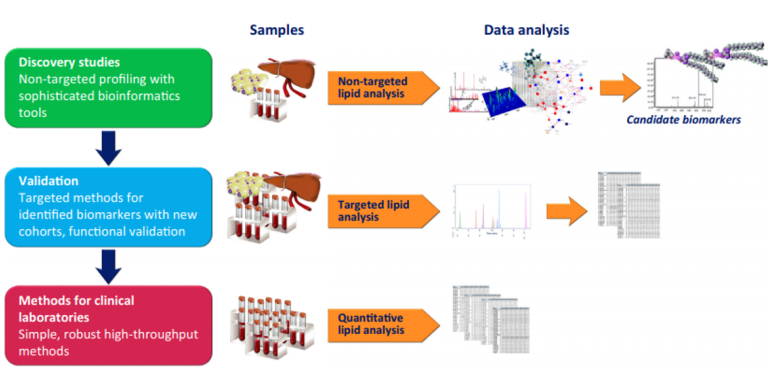Applications of Lipidomics in Discovery of Disease Biomarkers
Lipids are the energy providers of living organisms. Involving in a large number of vital body activities, lipids have very important physiological functions. Many diseases are closely related to lipid metabolisms, such as diabetes, cardiovascular disease, obesity, brain damage, Alzheimer’s disease (AD) and cancer. Lipidomics is used to detect all the lipids present in the biological matrix and the response of various stimuli or interventions to lipids, and has applications in cell biology, disease diagnosis and disease biomarker discovery, and pharmaceutical development.
The identification of disease-related early diagnostic indicators is key to clinical diagnosis. Lipidomics allows the elucidation of the relationship between lipid profiles and diseases and biomarker identification.

How to use lipidomics to analyze disease biomarkers?
The main methods used in lipidomics research are chromatography-mass spectrometry and birdshot methods.
- Liquid chromatography-mass spectrometry (LC-MS) method
LC-MS can be used for the separation, characterization and semi-quantitative determination of lipids in biological samples. This method is not only applicable to plasma, but also to other biological fluids and samples. Reversed-phase (RP), normal-phase (NP), hydrophilic interaction chromatography (HILIC) or ultra-performance liquid chromatography (UPLC) coupled with mass spectrometry can be used to determine lipid metabolism.
- Gas chromatography-mass spectrometry (GC-MS) method
GC is used in lipidomics to distinguish saturations of different lengths of lipid chains and their positional isomers. The lipids usually obtained are complex compounds and can be analyzed by multidimensional gas chromatography, especially by full two-dimensional gas chromatography. Lipid groups are further explored with columns of different selectivity. The GC-MS method is suitable for the analysis of fatty acids in complex samples and is sensitive to the positional isomers of saturated and unsaturated fatty acids.
- Shotgun lipidomics method
Shotgun lipidomics was first proposed by Han & Gross in 2003. Briefly, lipid extracts are directly injected into high-resolution tandem chromatography, and the target lipid molecules are characterized and quantified by appropriate multidimensional array analysis methods based on the effective in-source separation of lipid ions or fragments with different intrinsic charged properties using conventional lipid extraction methods for biological samples.
The separation of lipids is based on the fact that different classes of lipids have different charge properties, depending mainly on the nature of the head group. Shotgun lipidomics allows direct high-throughput screening and has great potential for biomarker discovery with high precision, good sensitivity and reproducibility. In contrast to traditional chromatography-mass spectrometry methods, the Shotgun method does not require chemical derivatization and can obtain relatively intact lipid ions. For the analysis of low abundance and low content of lipids, LC-MS method is superior to the shotgun method, because the high separation of chromatography can reduce the interference and make the MS detection results more accurate.
There are two commonly used detection techniques based on the birdshot method: electrospray ionization (ESI) tandem mass spectrometry and matrix-assisted laser desorption ionization time-of-flight mass spectrometry (MALDI-TOF-MS).
ESI is a soft ionization source mass spectrometry that readily produces excimer ions as well as relatively few fragment ions, thus eliminating the need for derivatization. Currently, ESI – MS method is one of the most popular methods used in lipidomics for lipid characterization and quantification. The advantages of ESI-MS /MS method are fast ion scanning, easy quantification and simple sample pre-treatment, which saves analysis time. In addition, using this method, highly targeted information can be obtained from the spectra and is relatively simple to analyze. Its disadvantages are the excessive dependence on the magnitude of the collision energy and the structure of the lipid molecule under test, as well as the high number of impurities contained in the sample due to its unpurified treatment, which may have some influence on the analysis of the results.
MALDI- TOF-MS is a new type of soft ionization biological mass spectrometry. MALDI-MS is a soft ionization method that analyzes samples after embedding them in a chemical matrix. The MALDI-MS method is sensitive, fast, easy to operate, and with low impurity interference and short detection time, which makes it suitable for analyzing a large number of samples. Its disadvantage is the difficulty of lipid quantification, especially when performing analysis of complex lipid compounds.



